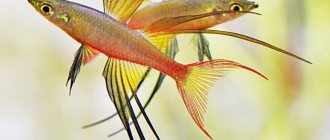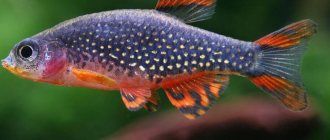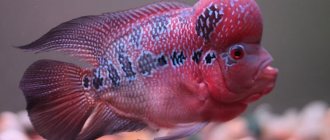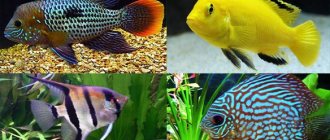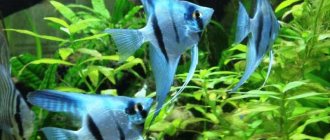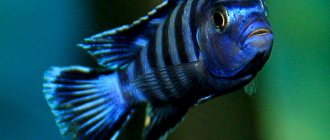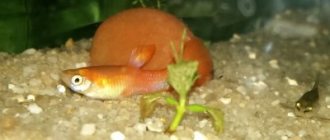The most beautiful aquarium fish: photo-video review and description
TOP OF THE MOST BEAUTIFUL AQUARIUM FISH
The beauty of the aquarium world is mesmerizing! This is why many people become interested in aquariums for life. The variety of aquarium fish is so countless and varied that sometimes choosing the best of the best, the most beautiful and beautiful fish becomes a difficult task.
I suggest you pay attention to the compiled TOP of the most beautiful fish and choose an aquarium beauty to suit your taste and color!
Your thoughts and preferences about the Miss Aquarium World ranking are very important to us. They will help shape public opinion! And make this TOP truly popular.
In order not to offend the participants of the topic, we will not assign places (for now), but will arrange them in alphabetical order, so...
Akara turquoise
The body of the fish is massive and tall. The color of turquoise acara varies from silver to green with a turquoise tint. There are turquoise-colored wavy lines on the gill covers and muzzle, and an irregularly shaped dark spot in the center of the body. A wide edging runs along the dorsal and caudal fin.
Burton's astatotilapia
Body coloration is variable. The main color is gray to reddish-yellow, may be brownish, with a blue, green or purple sheen on the side. There is a black vertical stripe across the eyes, and the same stripes on the forehead and muzzle. Lips are bluish. On the side, depending on environmental conditions and the condition of the fish, a pattern of longitudinal and transverse stripes of different saturation may appear.
Feeding
Feed your fish 2-3 times a day:
- food for cichlids;
- bloodworm;
- shrimp;
- crickets;
- grasshoppers;
- fish fillet;
- Gammarus.
Flower Horn eats live, dry and frozen food. He requires a large amount of protein, but you should not give your Horns mammalian meat.
Name of aquarium fish photo catalog video species.
NAMES OF AQUARIUM FISH.
Goldfish appeared almost more than a thousand years ago, the first color varieties of the Chinese silverfish. It is from them that the goldfish with all its many species traces its ancestry. The aquarium for goldfish should be large, with a substrate of large pebbles or gravel.
GOLDFISH Name of aquarium fish
COMET
The beautiful fish “at heart” remain crucian carp and, just like crucian carp, they dig in the ground, stir up water and dig up plants. You have to have powerful filters in the aquarium and plant plants with a strong root system or in pots. Body length up to 22 cm. The body is rounded, with long veil fins. The color is orange, red, black or spotted. Through many years of selection by aquarists of the Ancient East, it was possible to develop a huge number of beautiful varieties of goldfish . Among them: telescopes, veil-tails, celestial eye, or astrologer, shubunkin and others. They differ from each other in body shape, fins, color and have long lost their external resemblance to crucian carp
The name of the aquarium fish is COMET
Ancistrus
A rather small fish that can live in aquariums from 30 liters. The classic color is brown. Often these small catfish are confused with their larger counterparts - pterygoplichts. In general, it is a very hard-working fish and is good at cleaning build-up.
The name of the aquarium fish is ANCISTRUS
The Swordtail is one of the most popular aquarium fish. It is found naturally in the waters of Honduras, Central America, Guatemala and Mexico. The fish is viviparous. Males are distinguished from females by the presence of a sword-shaped process, hence the name. It has an interesting feature: in the absence of males, the female can change sex and grow a “sword”. They are also known to eat algae and snails.
Swordtails— Name of aquarium fish
Content: 24 - 26 °C; dH 8 - 25°; pH 7 - 8
Corridoras
Very cute and nimble catfish Corydoras. We would compare them to the Pomeranian of the dog world. A small bottom-dwelling fish that does not require special conditions feeds on what it can find at the bottom. As a rule, they are 2-10 centimeters long. If you don’t know who to put in the aquarium, buy Corydoras.
CORRIDORAS— Name of aquarium fish
Botia clown
This type of bot is the most popular among aquarists. Most likely due to the fact that clowns look very impressive, as can be seen in the photo. The peculiarity of the fish is the spikes that are located under the eyes. These spines can extend when the fish is in danger. They can live up to 20 years.
BOTIA CLOWN— Name of aquarium fish
Sumatran barb
Perhaps one of the most spectacular types of barbs - for this reason it is considered one of the most popular of its kind. They must be kept in a school, which makes the fish even more spectacular. The size in an aquarium is up to 4-5 centimeters.
BARBUS - Name of aquarium fish
SIAMESE ALGAE EATER is a peaceful and very active fish. The best assistant in the fight against algae. Inhabits the waters of Thailand and the Malaysian Peninsula. In nature it grows up to 16 cm, in captivity much less. Life expectancy in an aquarium can be 10 years. Eats algae of almost all types and even flip flops. Content: 24 - 26 °C; dH 4 - 20°; pH 6.5 – 7
ALGAE EATING - Name of aquarium fish
DISKUS is the most interesting and beautiful fish, a representative of the Cichlid family. The homeland of this fish is South America. Discus fish are calm, peaceful and a little shy. They live in the middle layers of water and do not get along well with angelfish and highly active fish. Should be kept in a group of 6 or more individuals. Very picky about water temperature. If the temperature is below 27 °C, then the discus get sick, refuse to eat and die. Content: 27 - 33 °C; dH up to 12°; pH 5 - 6
DISKUS - Name of aquarium fish
GUPPY is the most unpretentious fish, ideal for beginner aquarists. Habitat: Northern part of South America and the islands of Barbados and Trinidad. The male has a luxurious tail with a bright and beautiful pattern. The female is twice as large as the male and not as bright. This fish is viviparous. The aquarium must be closed. It is better to keep them in a species aquarium, since active neighbors can damage their veiled tails. Guppies are omnivores. Content: 20 - 26 °C; dH up to 25°; pH 6.5 – 8.5
GUPPY— Name of aquarium fish
Shark barb (bala)
Shark bala or barb is a fish that was so named as a result of its resemblance to sharks (this can be seen from the photo of the aquarium fish next to the description). These fish are large, they can grow up to 30-40 centimeters, so it is better to keep them together with other large barbs in a volume of 150 liters or more.
SHARK BALA— Name of aquarium fish
COCKER is a fighting fish. Found naturally in Southeast Asia. The only drawback is that males are very aggressive towards each other. They can grow up to 5 cm in length. Surprisingly, this fish breathes atmospheric air due to a special labyrinth organ. Keeping this fish does not require special knowledge. It is advisable to have an aquarium of at least 3 liters. Diversity in food is encouraged. Contents: 25 - 28 °C; dH 5 - 15°; pH 6 - 8
COCKER— Name of aquarium fish
GURAMI is a peaceful and beautiful fish. Belongs to the Labyrinth family. They are found in the waters of the large islands of Indonesia, the Malay Peninsula, and southern Vietnam. They get along with any neighbors and grow up to 10 cm. They live mainly in the upper and middle layers of water. They are most active during the daytime. Recommended for beginner aquarists. It is necessary to keep an aquarium of at least 100 liters with live plants and bright lighting. Content: 24 - 26 °C; dH 8 - 10°; pH 6.5 – 7
GURAMI - Name of aquarium fish
Danio rerio
A small fish up to 5 centimeters long. It is not difficult to recognize due to its coloring - a black body with longitudinal white stripes. Like all zebrafish, it is a nimble fish that never sits still.
ZANIO— Name of aquarium fish
Telescope
Telescopes come in gold and black. As a rule, they are not very large in size, up to 10-12 cm, so they can live in aquariums from 60 liters. The fish is spectacular and unusual, suitable for those who love everything original.
TELESCOPE— Name of aquarium fish
Black mollies
There are black, orange, yellow, and also mixed breeds. In shape they are a cross between guppies and swordtails. The fish is larger than its relatives described above, so it requires aquariums of 40 liters or more.
MOLLENESIA— Name of aquarium fish
Pecilia
Pecilia are the personification of a whole genus - the Poeciliidae. They can come in a variety of colors, from bright orange to variegated with black splashes. Fish can grow up to 5-6 centimeters.
PECILIIA - Name of aquarium fish
Macropod
A good fish that does not like encroachment on its territory. Although she is beautiful, she requires proper treatment. It is better not to plant them with their own kind; there are enough females and males of this species in the aquarium; they can get along with neons, guppies and other small species.
MACROPOD— Name of aquarium fish
NEON is an active, schooling, peace-loving and very shy fish. It comes from the Rio Negro River basin. In an aquarium it grows up to 3.5 cm, life expectancy is up to 5 years. Should be kept in a flock of at least 10 individuals. You should not add them to large fish, as neon can easily become their prey. Maintains in the lower and upper layers. The size of the aquarium is selected at the rate of 15 - 20 liters per couple of individuals. Food: small bloodworms, dry flakes. Content: 22 - 26 °C; dH up to 8°; pH 5 – 6.5
NEON— Name of aquarium fish
SCALARIA - angel fish. Found in South America in the Amazon and Orinoco rivers. This fish has been known to aquarists for many years. She is able to decorate absolutely any aquarium with her presence. This is a calm and schooling fish with a lifespan of 10 years. It should be kept in a group of 4 - 6 individuals. A large and hungry angelfish can eat small fish, such as neon. And a fish like a barb can easily pluck its fins and antennae. Prefers live food. Contents: 24 - 27 °C; dH 6 - 15°; pH 6.5 – 7.5
SCALARIA— Name of aquarium fish
Tetra
Tetra fish love when there are a lot of living plants in the aquarium, and therefore oxygen. The body of the fish is slightly flattened, the predominant colors are red, black and silver.
TETRA— Name of aquarium fish
Ternetia
Ternetia is also called the black tetra. The classic color is black and silver, with black vertical stripes. The fish is quite popular, so finding it in your city will not be difficult.
TERNETIA— Name of aquarium fish
Rainbows
The size of the fish varies, but in general they do not grow more than 8-10 centimeters. There are also smaller species. All fish are beautiful, silver in color, with different shades. The fish are schooling and live calmer in a group.
IRISH - Name of aquarium fish
ASTRONOTHUS is a large, calm and slightly shy fish. Found in the Amazon River basin. In an aquarium it can grow up to 25 cm, life expectancy can be more than 10 years. Can eat little neighbors. The aquarium is selected at the rate of 100 liters per individual. There should be no sharp decorations, as astronotuses can injure themselves in a panic. The aquarium must be closed. Should be fed with live food. Content: 23 - 26 °C; dH up to 35°; pH 6.5 – 8.5
ASTROTONUS— Name of aquarium fish
BLACK KNIFE - bottom and night fish. Lives in overgrown parts of the Amazon River. Has an interesting body structure. Can move in any direction. In an aquarium it grows up to 40 cm. During the daytime it mainly hides. It is better to keep them alone, as clashes may occur between large individuals. An aquarium of 200 liters or more with driftwood, live plants and a large number of shelters made of stones is suitable for keeping. Feeds on live food. Content: 20 - 25 °C; dH 4 - 18°; pH 6 – 7.5
FISH KNIFE— Name of aquarium fish
Coral Reef & 3 HOURS Relax Music HD 1080p
Beautiful aquarium for 4 thousand liters HD video
Content
Such large fish require a spacious aquarium and expensive equipment. The aquarist needs to monitor the cleanliness of the water, as the horn litters while eating. Remove any uneaten food floating in the water immediately. The fish's diet is full of live food, which quickly deteriorates the water quality. Maintenance of the aquarium is complicated by the fact that the pet can attack the hand.
Aquarium
An aquarium of 100–200 liters with a lid is suitable for one individual, 400–450 liters for a couple, and at least 800 liters with plenty of hiding places when keeping a horn with other species. In an aquarium with flowerhorns, driftwood, rocks and grottoes look good.
Reviews
Ivan Bystrov, 45 years old, Omsk. Friends gave Horn away at the age of 1 year. He was thin and lethargic. He has fattened up and eats almost everything. While he was fiddling around, he got used to me. Now he is 4 years old and has never bitten me.
Maria Pavlova, 36 years old, Novosibirsk. I have been breeding and raising Horns for several years. They bite hard, the bite is comparable to an electric shock. To protect my hands, I began to clean the aquarium once every 2 weeks. I can say that fish are opportunists.
Inga Sharapova, 50 years old, Cheboksary. I am a fan of Horns and have been breeding them for several years. I recently bought an individual with unique characteristics - the stripes on its sides resemble hieroglyphs. The fish is beautiful, but expensive; for one fish they ask for about 70,000 rubles.
Flowerhorn is an aquarium fish that breeders worked on to create. The pet is distinguished by a bump on its head. Despite this, both male and female individuals attract attention and are considered one of the most beautiful, intelligent and picky inhabitants of the aquarium.
Reproduction
Flowerhorns breed in a spawning aquarium. The difficulty in breeding lies in the fact that the fish can injure each other during the spawning period. You need to constantly monitor your pets.
Sex differences
It is quite difficult to distinguish between male and female horns. It is believed that females have a dark spot on their dorsal fin, which males do not have. But experienced aquarists deny this fact.
All flowerhorns have a hump on their heads. In males it is much larger, so you can determine the sex at first glance.
Spawning
Hornets become sexually mature at 1 year of age, but can reproduce only at 2 years of age. The fish need to be stimulated to spawn. To do this, change the water as often as possible and increase the temperature to 28 degrees.
The size of the aquarium for spawning is at least 150 liters per pair, equipped with shelters. Divide the tank into 2 compartments using a mesh. This is necessary so that the male does not injure the female. Stretch the net 10 cm from the bottom and place a flat stone under it, closer to the female.
The female will lay eggs on this stone. A clutch can contain from 700 to 1000 units. You can increase the fertilization percentage by placing the filter so that the flow is directed from the male to the female. The male fertilizes the eggs. After 3 days, the larvae are born.
Care of offspring
After 2 days, the hatched fry are already swimming and feeding on live dust. During the month, the parents take care of the brood; the aquarist should gradually introduce dry egg yolk and brine shrimp into the young animals’ diet.
A month after hatching, the fry can be separated from their parents. The characteristic color appears at the age of 6 months. But it can differ significantly from what the parents have. Sometimes beautiful pets produce fish with dull and faded scales.
How to use
Once stabilized, moss becomes a decorative material that is too fragile to walk on. Therefore, in horizontal design it is found as part of the interior of living corners or in tabletop ikebana. More often it can be found in vertical gardening in the following compositions:
- Phytowalls . A trendy type of landscaping when the wall surface is completely covered with a green carpet. The decor is beneficial where it is too dark for living plants. To enhance the effect, moss is supplemented with other stabilized plants and lighting. A phytowall can become part of a living space, office, boutique, or business center.
Refreshing effect of phytowall Source stroyfora.ru
- Panels, panels . If a phytowall does not fit with your ideas about comfort, you can limit yourself to a picturesque panel enclosed in a frame. Moss can act as a solo decoration or be combined with other plants. You can use spray paint to change its color.
- Decorative inserts . They can be located anywhere: in a niche on the wall, under the glass of a coffee table, as an unusual lampshade or decoration of a flower pot, in the winter garden.
Coffee table in the recreation area Source pinimg.com
See also: Catalog of companies that specialize in finishing materials and related work
Compatibility
It is safer to keep a Hornhorn alone. When keeping 2 fish in a small volume, harassment is inevitable, even if you house a male and a female. If there is a large reservoir, then flower horns will get along with the following species:
- black pacu;
- Managuan cichlazoma;
- astronotus;
- Pterygoplichthus;
- plecostomus;
- giant gourami.
Take a look at this post on Instagram
Addition, expansion Nikita (@nikitagornushkin) April 14, 2021 about 9:14 PDT
Variety of materials
The following types of plants are used for processing and further decoration:
- Plast moss . It is convenient to assemble phytowalls, panels and other vertical decor from layers with a homogeneous structure. They combine well with other stabilized plants and are easier to process and paint.
- Yagel . The voluminous and textured material is pale gray in color and needs to be carefully collected. In its stabilized form, it is also quite vulnerable. Sources of excess heat, such as heaters or halogen lamps, should not be placed near such decor. He also does not like direct sunlight.
- Hummocks . Spectacular voluminous decor, denser than previous varieties. Hummocks, as part of nature, enliven the interior and make it more comfortable. They are used as an element of flower arrangements or independently.
Scandinavian style kitchen Source mrdoors.ru
What fish can be combined with in the same aquarium?
Flowerhorns are aggressive inhabitants of aquariums who zealously guard their territory. Ideally, it is better to keep the fish separately in a species tank. But if the volume of the container allows you to accommodate other pets, then give preference to proportionate cichlids:
- astronotus;
- Managuan cichlazoma;
- Akara;
- black pacu.
Large-sized catfish - pterygoplichths, plecostomus - can become neighbors of horns. Horns are predators, so the small fish introduced will become food on the same day.
Adviсe
- If you need an aquarium fish with expressive colors, choose an adult Horn. Juveniles may acquire a dull coloration during their lifetime.
- Plexiglas containers retain heat. Such an aquarium is useful during power outages or in cold weather.
- If you plan to keep several fish, let them get used to each other from childhood. This will increase the likelihood of cohabitation without injury.
- If injuries occur in the aquarium population, disinfect the water with methylene blue to avoid fungal infections.
- Sometimes it is more profitable to buy all the necessary equipment and an aquarium in one store.
- To avoid moving decorations with flowers, secure items by burying them deeper in the ground or using glue.
- When breeding fish, find out how pure the flower breed is. Bright producers have dull fry.
Cichlids are recognized as the smartest aquarium inhabitants. They have a good memory. However, other types of fish also have amazing abilities: they remember sleeping and feeding places, feeding times, distinguish friendly neighbors from enemies and understand when they are in danger.
Previous
Fish Why is the catfish and panda called a bear?
Next
FishSmall aquarium fish cardinal
Diseases
Flowerhorns have a strong immune system; if the aquarium is well cared for, the fish do not get sick. With unsuitable parameters and low water quality, fish are susceptible to:
- Poisoning. An increased concentration of nitrogen compounds leads to oxygen starvation. Flowers breathe rapidly, stay in the upper layers of water and sometimes try to jump out. At the same time, the gills darken, and with prolonged exposure to harmful substances, the fish becomes depressed and loses appetite. Test the water for nitrites and replace gradually. Increase aeration. If the water temperature is too high, lower it to 26–28 degrees, then the liquid will be better saturated with oxygen.
- Acidosis. Occurs at low pH levels. Flowerhorns lie on their sides, hide and breathe rapidly. If there are plants, greenery dramatically accelerates the growth rate. Check the water parameters, replace some of the liquid. Pour in hydrogen peroxide (1 ml per 1 liter of water).
- "Black Chin" Appears in low quality water. Darkening appears on the chin and body of the fish. No treatment has been developed. Smoothly replace contaminated water.
- Hexamitosis. Recesses filled with mucus appear on the body. Remove the sick individual. Mix furazolidone with food (0.06 g of the drug per 100 g of food). Give the medicine for a week.
Briefly about the main thing
Stabilizing moss at home allows you to use natural material to make a variety of decor. In order for the result to be high-quality and long-lasting, you should start with the correct harvesting and preparation of layers of moss or reindeer moss.
At home, plants are stabilized in two ways: with glycerin or a mixture of glycerin and methyl alcohol; the second method takes less time. Dye is added to the mixture to maintain the rich shade. Properly preserved plants look natural and remain flexible.
Ratings 0
